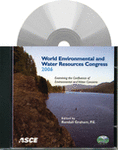A Watershed Nutrient Management Model: System Dynamics and Transport Rates Approach
Publication: World Environmental and Water Resource Congress 2006: Examining the Confluence of Environmental and Water Concerns
Abstract
A watershed nutrient management model was developed using a combination of system dynamics (SD) and nutrient flow (NF) models to assist decision makers and stakeholders with watershed management planning for the conservation of water resources and rural development. The SD model simulates changes in socioeconomic factors such as population, land use, and economic indices; the NF model calculates in-stream nutrient loads by using nutrient transport rates, population, and land use area; the latter two are outputs of the SD model. These models were developed and calibrated for the Cianjur watershed located in West Java, Indonesia. Rapid changes in the population and land use in this region have caused associated environmental problems and have adversely affected surface water quality. The maintenance of a balance between rural environment conservation and development is an important concern. The SD model comprises six sectors (population, land use, industrial capital, agricultural capital, water resources, and water quality). Elements used in the model were selected based on literature reviews and field investigations, and then the causal loops were created. After the SD model was calibrated manually for the period 1988 to 2000, the relative errors between the historical and calculated values were 2.6% for the total population, 13.2% for the area of irrigated paddy fields, and 6.4% for Gross Regional Domestic Production. The results of a sensitivity analysis were found to correlate well with the historical data. In constructing the NF model, the nutrient loads in surface water were estimated using transport rates that were calculated using an exponential equation based on the distances from the pollutant source to the nearest waterbody and to the mouth of that waterbody. The model was calibrated using measurement data collected during field investigations in 2003 and 2004. The locations of pollutant sources (residential areas and paddy fields), and the distances from each source to the nearest waterbody were determined using a geographical information system (GIS). The model simulated the in-stream nutrients reasonably well. Finally, using the models developed, scenario analyses were conducted to demonstrate the functionality of the models.
Get full access to this chapter
View all available purchase options and get full access to this chapter.
Information & Authors
Information
Published In
Copyright
© 2006 American Society of Civil Engineers.
History
Published online: Apr 26, 2012
ASCE Technical Topics:
- Business management
- Dynamic models
- Engineering fundamentals
- Engineering mechanics
- Flow (fluid dynamics)
- Fluid dynamics
- Fluid mechanics
- Freight transportation
- Hydrologic engineering
- Infrastructure
- Logistics
- Management methods
- Models (by type)
- Practice and Profession
- Resource management
- River engineering
- River systems
- Systems engineering
- Systems management
- Thermodynamics
- Transport phenomena
- Transport rates
- Transportation engineering
- Water and water resources
- Water management
- Water supply
- Water supply systems
- Watersheds
Authors
Metrics & Citations
Metrics
Citations
Download citation
If you have the appropriate software installed, you can download article citation data to the citation manager of your choice. Simply select your manager software from the list below and click Download.
